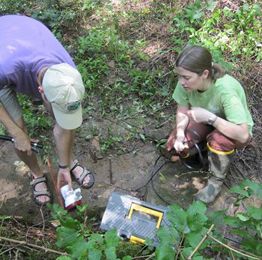Sensors & Field Instruments
In-Situ Sensors and Instrumentation
The Christina River Basin Critical Zone Observatory is developing and deploying an advanced sensor network for real-time observations of hydrological and biogeochemical processes.
These sensors range from basic meteorological and hydrological sensors that can be widely deployed at low cost, to advanced commercial field-instrumentation such as submersible UV-Vis spectrometry, to home-made geochemical sensors constructed from readily available electronic components.
We are beginning to participate in the emerging open-source hardware movement to further the development of environmental sensors. Visit the CRB-CZO sensor blog at czo.stroudcenter.org/sensors.
Placing in-channel instrumentation in a small tributary of White Clay Creek before Hurricane Irene, 2011. Photo: Erika Vazquez.
NEW! Visit the CRB-CZO sensor blog at czo.stroudcenter.org/sensors/
Wireless Sensor Networks for Watershed Assessment: Emerging Technologies
Implementing a large scale sensor deployment for watershed assessment has previously been limited by the high cost of the datalogging and communication infrastructure.
The Christina River Basin Critical Zone Observatory (CRB-CZO) is overcoming the obstacles to large near-real-time data collection networks by using Arduino, an open source electronics platform, in combination with XBee ZigBee wireless radio modules.
The open-source nature of Arduino means the cost is extremely low compared to similar commercial electronics options.
By significantly decreasing the cost of the datalogging and communication hardware, resources can be focused on installing more sensors for greater spatial coverage.
Researchers, students, and individuals can easily build and deploy inexpensive dataloggers without the need for electronics experience, complicated software, or specialized tools. Dozens of low cost boards allow even novice users to build devices using boards that connect in a modular framework.
Benefits of Open-Source Datalogger Hardware
A 16-channel, solar-powered Arduino datalogger node with self-meshing wireless communication = $150
- Low Cost: For around $150, we can replicate the capabilities of a $3000 wireless commercial datalogger system.
- Ease of use: The Arduino electronics prototyping platform was initially designed “for artists, designers, hobbyists, and anyone interested in creating interactive objects or environments.” As such, the Arduino family of electronics hardware is easy to snap together and program; yet it is also capable of nearly any task we might imagine.
- Support: The large user community provides support as well as constant innovation and development of new hardware and applications
- Reliability: Self-healing mesh wireless networks route the radio signal from the nodes to the base station using the most efficient route. Each node also has a removable memory card to store a backup of the sensor data
- Compatibility: Commercial dataloggers can join an Arduino mesh network by simply connecting an Xbee radio module to the logger so it can transmit the data that it usually only stores on its internal memory
Our Preliminary Results
We believe that using open-source electronics hardware for watershed instrumentation will transform our ability to deploy sensors, field instruments, and other electronic “eyes and ears” to unprecedented levels. High quality commercial sensors are relatively inexpensive and widely available. Easy customization of the Arduino node interface hardware and software means virtually any sensor can be used.
- Datalogger nodes consist of a microprocessor board paired with a radio module, all mounted in a weatherproof enclosure along with a solar panel and rechargeable battery.
- The nodes conserve battery power by sleeping most of the time, then waking periodically to take measurements from the sensors, and then transmitting their data through the mesh back to the base before going back to sleep.
- In areas with no mesh network, standalone loggers with just a memory card can be used.
Custom Devices
Other custom devices such as a remote streamwater sampling system and a multi-chamber respirometer controller can be built using the same type of Arduino microprocessor boards. See Gallery below for examples.
Links:
Arduino Electronics Platform
Online Resources, Tutorials, Products
- Arduino forum
- Forum for Adafruit Industries, an open-source hardware company that sells kits and parts for original, open source hardware electronics projects
- http://www.sparkfun.com/tutorials
Xbee ZigBee Radio Modules
The information in this page was presented at the 2011 Fall Meeting of the American Geophysical Union. View the poster in the Associated Files section below.
Arduino datalogger
A 16-channel, solar-powered Arduino datalogger node with self-meshing wireless communication = $150
Gallery
Custom devices for wireless sensor networks

Remote water sampling control board with prepaid cell phone

Soil moisture datalogger

Laboratory respirometer

Portable respirometer
Custom devices such as a remote streamwater sampling system and a multi-chamber respirometer controller can be built using open-source Arduino microprocessor boards. For wireless sensor network ideas, designs, and source code, visit the CRB-CZO sensor blog.
Associated Files
Hicks et al. 2011, AGU poster
(1 MB pdf)
Sensor Networks, Dataloggers, and Other Handy Gadgets
Using Open-Source Electronics for the Christina River Basin CZO. Presented at the 2011 Fall Meeting of the American Geophysical Union
Hicks et al. 2012, AGU poster
(2 MB pdf)
H11I-1285: Creative Uses of Custom Electronics for Environmental Monitoring at the Christina River Basin CZO. Presented at the 2012 Fall Meeting of the American Geophysical Union
Explore Further



